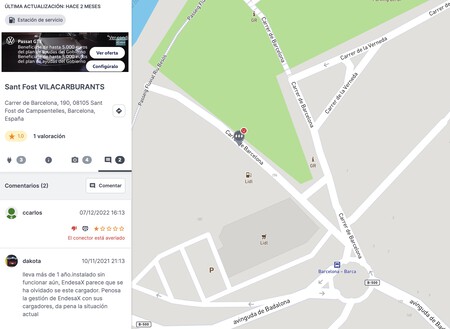Spain lives in a continuous headache with its plugs for electric cars. in his last Electromobility BarometerAnfac assured that Spain had barely installed 10% of the plugs that it should have made available to drivers by the end of 2022.
The goal by the end of 2022 was to have 45,000 charging points in our cities and highways. The latest count placed the figure at just 13,411 charging points, with a growth of 3,154 new charging points available in the first three quarters of 2022.
To try to solve this situation, the Government has launched a new process that tries to lighten the bureaucracy necessary to install new plugs at gas stations. The goal is to reduce bureaucracy and expedite procedures to achieve a much denser charging network than the current one.
This has been the latest political decision to try to increase the available plugs, but a maneuver was launched a long time ago to force gas stations to provide their facilities with charging points for electric cars.
In the Order TED/1009/2022 It has already been specified that service stations with sales over 10 million liters of gasoline and diesel in 2019 must install at least a 150 kW recharging point and those with sales of more than five million liters must face the installation of a 50 kW plug.
Now, the oil companies accuse the electricity companies of torpedoing their entry into the market. And the electric ones to the administration.
40,000 charging stations in limbo
The overall photography is surreal. According to Expansion, 40,000 applications for the installation of charging points are at a standstill, turning in the vicious bureaucratic circle. An investment that reaches 6,000 million euros.
While the buyer of an electric car continues to encounter difficulties during long trips and Spain receives 6.2 points in the Anfac charging infrastructure indicator (the European average is 12.1 points), oil companies, electric companies and the administration are accused each other from the jam.
According to the economic newspaper, the oil companies are accusing the electricity companies of slow down on purpose the connections dependent on them with their facilities. In turn, the electric companies accuse each other, since the distribution networks depend on different groups depending on the region and, therefore, they accuse each other of prioritizing their charging points or slowing down the connections of the competition’s plugs.
And finally, the electric companies also accuse the administrations (at all levels: municipal, regional and state) assuring that the bureaucratic jam prevents them from supplying the demanded electricity network.
The result is that there are charging points whose infrastructure has been installed for months but which still do not receive power and, therefore, cannot be used. a walk through Electromaps It is used to verify this situation.
Plugs without energy in Catalonia

Plugs without energy in Extremadura

Plugs without energy in León
The problem, says Expansión, is that setting up a charging point is a real bureaucratic hell. This is how Miguel A. Patiño exemplifies it in his article:
“In order to contract the corresponding supply to activate a charging point with an electricity supplier, it is necessary to present the documentation that accredits the correct legalization of that charging point before Industry”
From the newspaper they clarify that the process is digital in the best of cases, but that in some autonomous communities they work with manual records and, furthermore, the town halls do not always use the same procedure when registering the applications.
The result is the meager charging network that electric car owners have at their disposal. On average, it takes between 18 and 24 months to put a plug into operation, despite the fact that the works to be carried out should hardly take more than two weeks.

And to all of the above is added the enormous lack of judgment when carrying out the installations. There is no clear criteria that specifies the number of plugs or the power that an electric station must have. Thus, some facilities have dozens of plugs and different powers, while others only provide service with a slow charging socket and a fast charging socket.











![[Img #74362]](https://thelatestnews.world/wp-content/uploads/2024/11/A-new-biomarker-of-Parkinsons-disease-progression-300x200.jpg)
